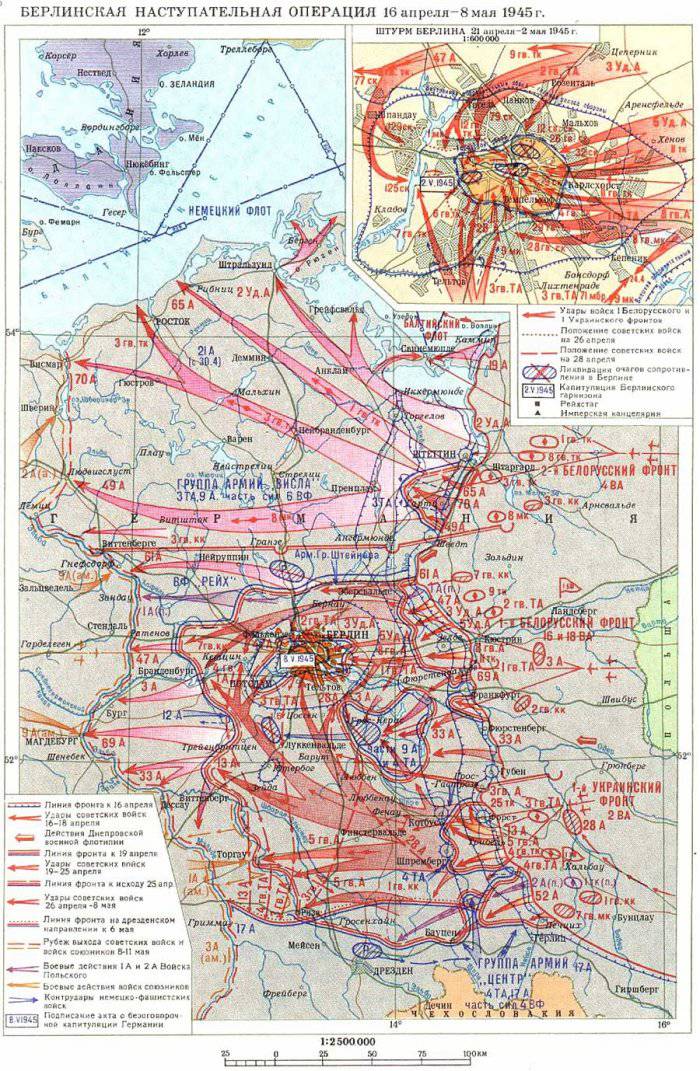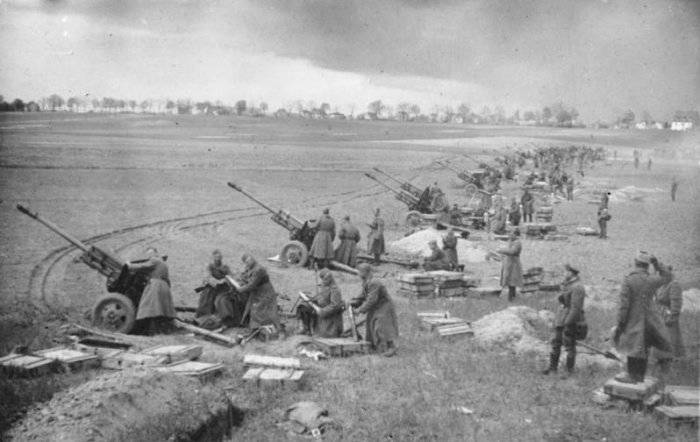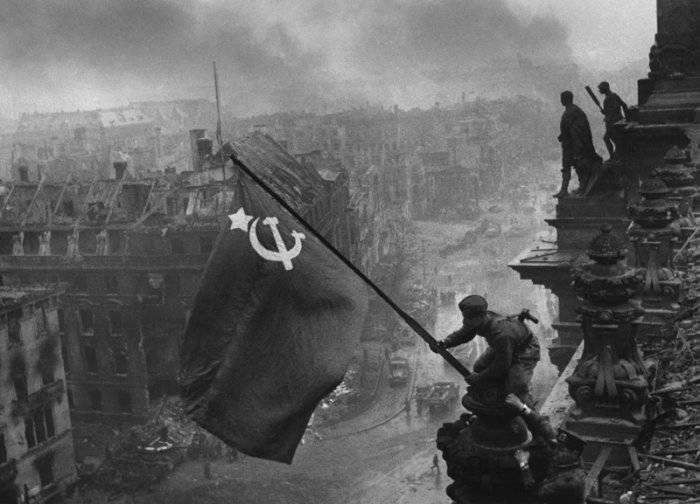Berlin offensive
The operation continued 23 of the day, from April 16 to 8 May 1945, during which Soviet troops advanced westward to 100-220 km. Within its framework, private offensive operations were carried out: the Stetta-Rostock, Zelovsko-Berlin, Cottbus-Potsdam, Shtremberg-Torgau and Brandenburg-Rathenovskaya. Three fronts took part in the operation: the Belarusian 1 (G. K. Zhukov), the Belarusian 2 (K. Rokossovsky) and the Ukrainian 1 (I. Konev).
Plan, plans of the parties
The plan for the operation at GHQ was determined as early as November of the 1944 of the year, it was clarified in the course of the Vistula-Oder, East Prussian, Pomeranian operations. The actions on the Western front and the actions of the Allies were also taken into account: they reached the Rhine at the end of March - beginning of April and began to force it. The Allied High Command planned to seize the Ruhr industrial area, then go to the Elbe and launch an offensive in the Berlin direction. At the same time, in the south, the US-French troops planned to seize the districts of Stuttgart, Munich, and enter the central parts of Czechoslovakia and Austria.
At the Crimea Conference, the Soviet occupation zone was supposed to pass west of Berlin, but the Allies themselves planned to launch the Berlin operation, and there was also a high probability of a separate deal with Hitler or his military, with the aim of surrendering the city to the United States and England.
Moscow had serious concerns, the Anglo-American troops almost did not meet with serious resistance in the West. In mid-April, 1945, the American radio browser, John Grover, said: "The Western Front does not actually exist anymore." The Germans, having moved beyond the Rhine, did not create a powerful defense, moreover, the main forces were transferred to the east, and even in the most difficult moments of the Ruhrish group of the Wehrmacht, forces were constantly taken and transferred to the Eastern Front. Therefore, the Rhine surrendered without serious resistance.
Berlin tried to prolong the war, restraining the onslaught of the Soviet armies. At the same time leading secret negotiations with Westerners. Wehrmacht from the Oder to Berlin built a powerful defense, the city itself was a huge fortress. Operational reserves were created, in the city and its environs detachments of the national militia (battalions of the Volkshturm), in April only in Berlin there were 200 battalions of the Volkssturm. The base defense centers of the Wehrmacht were the Oder-Neissen defensive line and the Berlin defensive area. On the Oder and Neisse, the Wehrmacht created three defensive lines 20-40 km deep. The most powerful fortifications of the second lane were on the Seelow Heights. The engineering units of the Wehrmacht made good use of all natural obstacles - lakes, rivers, heights, etc. d., turned the settlements in the strongholds, special attention was paid to anti-tank defense. The enemy created the highest density of defense in front of the Belarusian Front 1, where in the 175-km-wide band the defense was occupied by Wehrmacht 23 divisions and a significant number of smaller units.
Offensive: major milestones
- At 5 a.m. on April 16, the 1st Belorussian Front on a site of 27 km (breakout zone) 25 minutes from more than 10 thousand artillery barrels, rocket systems, mortars destroyed the first line, then transferred fire to the second line of enemy defense. After that, they turned on 143 anti-aircraft searchlights to blind the enemy, struck the first lane in one and a half to two hours, and in some places went to the second. But then the Germans woke up, tightened reserves. The battle became even more fierce, our rifle units could not overcome the defense of the Zeelov Heights. In order not to disrupt the timing of the operation, Zhukov brought into battle the 1st (Katukov M.E.) and the 2nd (Bogdanov S.I.) guards tank army, the German command at the end of the day threw into battle the operational reserves of the Army Group "Wisla". All day and night of the 17th there was a fierce battle, in the morning of the 18th part of the 1st Belorussian, with the help of aviation The 16th and 18th air armies were able to take the heights. By the end of April 19, the Soviet armies, breaking through the defenses and repulsing the enemy’s fierce counterattacks, broke through the third line of defense and were able to strike at Berlin itself.
- On April 16, a smoke screen was installed on the 390-kilometer front of the 1 of the Ukrainian front, an artillery strike began on 6.15, and advanced units crossed the Neisse on 6.55 and captured the bridgeheads. The crossings for the main forces began, only in the first hours did the 133 crossings be built, by the middle of the day the troops broke through the first line of defense and reached the second. The command of the Wehrmacht, realizing the gravity of the situation, on the very first day threw into battle tactical and operational reserves, setting the task of knocking our forces out of the river. But by the end of the day, the Soviet units broke through the second line of defense; in the morning of the 17, the 3 (Rybalko, P. S.) and 4 (Lelyushenko D. D.) guards tank armies crossed the river. From the air, our armies were supported by the 2-I Air Army, the breakthrough expansion was going on all day, by the end of the day the tank armies reached the Spree River and immediately began to force it. On the secondary, Dresden direction, our troops also broke through the front of the enemy.
Considering the fierce resistance of the enemy in the strike zone of the 1 of the Belarusian Front and its lagging schedule, the success of its neighbors, the tank armies of the 1 of the Ukrainian were ordered to turn to Berlin and go without getting involved in the battles to destroy the strongholds of the enemy. 18 and 19 April 3-I and 4-I tank armies went to Berlin, the pace in 35-50 km. At that time, the combined-arms armies were preparing for the liquidation of enemy groups in the Cottbus and Spremberg area. 21-nd tank army Rybalko, suppressing fierce resistance of the enemy in the area of the cities of Zossen, Luckenwalde, Utterbog, went to the external defensive lines of Berlin. The 22 of the 3 of the Guards Tank Army overcame the Notte Canal and broke through the external fortifications of Berlin.
- April 17-19 advanced units of the 2 of the Belarusian Front conducted reconnaissance in force and captured the Oder interfluve. On the morning of 20, the main forces launched an offensive, covering the Oder covered with artillery fire and a smoke screen. The most successful was achieved by the right-flank 65 Army (P.I. Batov), having captured a bridgehead of 6 width and 1.5 km depth in the evening. At the center of the 70 army, a more modest result was achieved, the left-flank 49 army failed to gain a foothold. 21-th all day and night there was a battle to expand the bridgeheads, K. K. Rokossovsky threw parts of the 49-th army to support the 70-th army, then threw into the battle 2-th shock army, as well as 1-th and 3-th Guards tank corps. The 2 Belorussian Front was able to forge off parts of the 3 of the German army by its actions; it could not come to the aid of the defenders of Berlin. The 26 part of the front was taken by Stettin.
- On April 21, units of the 1st Belorussian Front broke into the suburbs of Berlin, battles were fought on 22-23, on the 23rd the 9th Rifle Corps under the command of Major General I.P. forced her on the move. Great help in its acceleration was provided by the Dnieper Military flotillasupporting fire and transferring troops to the other side. Our units, leading their own and repulsing the enemy’s counterattacks, suppressing their resistance, went to the center of the German capital.
- The 61 army and 1 army of the Polish Army operating in the auxiliary direction launched an offensive against 17, breaking through the defenses of the enemy, bypassed Berlin from the north and went to the Elbe.
- 22-th in Hitler’s Headquarters, it was decided to transfer W. Wenk's 12 Army from the Western Front, Keitel was sent to organize its attack on the aid of the semi-encircled 9 Army. By the end of 22, the troops of the 1 of the Byelorussian and 1 of the Ukrainians practically created two circles of encirclement - around the 9 of the army east and southeast of Berlin and west of Berlin, surrounding the city itself.
- The troops reached the Teltow Canal, the Germans created a powerful defense on its shore, preparing for the assault on 23 all day, artillery was tied up, on 1 km it was up to 650 trunks. On the morning of 24, the assault began, suppressing the enemy firing points with artillery fire, the canal successfully crossed parts of Major-General Mitrofanov's 6 Guards Tank Corps and captured the bridgehead. In the afternoon of 24, Wenk's 12 Army struck, but was beaten off. In the 12 watch of the 25, west of Berlin, the units of the 1 of the Byelorussian and 1 of the Ukrainian Fronts joined, and an hour and a half later our troops met on the Elbe with American units.
- On April 20-23, divisions of the German Army Group “Center” attacked units of the 1 of the Ukrainian Front on the left flank, trying to get to its rear. From April 25 to May 2, troops of the 1 of the Ukrainian Front fought in three directions: units of the 28 Army, 3 and 4 of the Guards Tank Armies fought in Berlin; The 13 army together with the units of the 3 tank army beat the attacks of the German army 12; The 3-th Guards Army and part of the 28-th army units held back and destroyed the surrounded 9-th German army. Fighting to destroy the German 9 Army (200 thousandth Frankfurt-Guben group) went to May 2, the Germans tried to break through to the west, skillfully maneuvering. Creating superior strength in narrow sectors, they attacked, twice broke through the ring, only the emergency measures of the Soviet command allowed them to be re-blocked and eventually destroyed. Only small groups of the enemy could break through.
- In the city, our troops met with fierce resistance, the enemy did not think to surrender. Relying on numerous facilities, underground communications, barricades, he not only defended, but constantly attacked. Ours acted with assault groups, reinforced by sappers, tanks, artillery, and by the evening of the 28 division of the 3 shock army reached the Reichstag area. By the morning of 30, after a fierce battle, the building of the Ministry of the Interior was seized, and the Reichstag was stormed, but on the night of 2, the German garrison surrendered. On May 10, the Wehrmacht was left with only the government quarter and Tiergarten, the chief of the general staff of the German ground forces, General Krebs, offered a truce, but ours insisted on unconditional surrender, the Germans refused, the fighting continued. On May XNUM, General Weidling, commander of the city’s defense, announced the surrender. Those German units that did not accept it and tried to break through to the west were scattered and destroyed. So ended the Berlin operation.
The main results
- The main forces of the Wehrmacht were destroyed, the German command was no longer able to continue the war, the capital of the Reich, its military-political leadership was captured.
- Wehrmacht after the fall of Berlin almost ceased resistance.
- In fact, the Great Patriotic War was completed, it remains only to issue the capitulation of the country.
- Hundreds of thousands of prisoners of war, slaves of Soviet people were released.
- The Berlin offensive operation demonstrated to the whole world the high combat skill of the Soviet armies, its commanders and was one of the reasons for the cancellation of Operation Unthinkable. Our "allies" planned to strike the Soviet army in order to force it into Eastern Europe.
Sources of:
Zhukov G. K. Memoirs and reflections. The 2 TM., 2002.
Keitel W. 12 steps to the scaffold ... - Rostov n / A., 2000.
Konev I.S. Forty-fifth. - M., 1970.
Rokossovsky K. K. Soldier debt. 1988.



Information